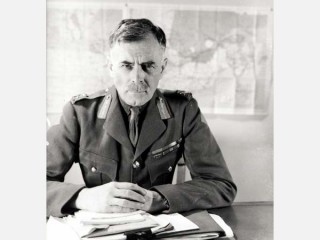
Andrew McNaughton biography
Date of birth : 1887-02-25
Date of death : 1966-07-11
Birthplace : Moosomin, North West Territories, Canada
Nationality : Canadian
Category : Famous Figures
Last modified : 2010-12-03
Credited as : Army officer, ,
Andrew McNaughton was Canada's most prominent soldier in the 20th century. AfterWorld War II McNaughton served in a variety of political and diplomatic capacities.
Andrew George Latta McNaughton was born February 25, 1887, at Moosomin, North West Territories (now Saskatchewan), Canada. He enlisted in the army reserve in 1909 and by 1914 commanded the 3rd Field Battery in Montreal while doing academic research and lecturing in electrical engineering at McGill University.
He fought as a gunner with the Canadian Corps on the Western Front throughout World War I. In a war in which artillery became the dominant arm, McNaughton attracted attention and won steady advancement largely on the basis of his organizational skills and application of scientific principles to techniques such as sound ranging and barrage fire. Twice wounded, three times mentioned in despatches, by war's end he had been awarded the Distinguished Service Order (DSO) and was a brigadier general.
There McNaughton's military career might have ended, but his old Canadian Corps commander, Gen. Sir Arthur Currie, convinced him to join the permanent army. He was soon deputy army chief, bringing his science skills to bear on a northern radio signals system using improved survey techniques based on aerial photography and the cathode ray detection finder, an essential component of what would become radar. He became chief of the general staff on the first day of 1929, dominating his colleagues in the military establishment, as one author puts it, "as a great oak dominates a scrub forest."
In 1930 a Conservative government came to power under an admiring R. B. Bennett, and McNaughton extended his influence throughout official Ottawa. During the worst days of the Depression he held sway over numerous committees, ran the government's unemployment relief program, and made inquiries into a St. Lawrence seaway system. As the chief military adviser of a hard-pressed government, however, he was unable to push through major reforms or strengthen Canada's armed forces. His valedictory in 1935 was a memorandum on the low state of the country's defenses. The presidency of the National Research Council was next, McNaughton immersing himself in the problems of preparation for a scientific war which it seemed must come before long.
When war did come again, McNaughton was chosen as commander of the Canadian division which was sent to England in December 1939. He looked the part. McNaughton, one journalist wrote, "was the answer to a propagandist's prayer. His iron-grey head, miraculously photogenic, was the epitome of last-ditch fight. He played himself and his hand uniformly—to the full." He was a fine trainer and motivator, building his force to army strength by 1942 while launching a wide variety of technological innovations. McNaughton felt passionately about his army and its men, and they reciprocated his affection. He spoke often and eloquently about the need for national control of Canada's armed forces. That, especially for a young country, was the acid test of sovereignty.
McNaughton had weaknesses, and his sheer visibility made them more apparent. His judgment, a leading historian has said, was never the equal of his intellect. Compromise did not come easily. His nationalism made enemies among Canadian politicians and military bureaucrats. He over-worked and, with his health in question, British reservations about his qualities as a commander became impossible to ignore. He resigned in December 1943. "Whether McNaughton would have proved an effective commander in the field may be questionable," wrote the British military theorist Sir Basil Liddell Hart, "but he was certainly a soldier of outstanding visions and ability who grasped the conditions of modern war earlier and more fully than most."
McNaughton's prestige, not least with wartime Prime Minister Mackenzie King, was undiminished. A member of his staff in England captured the widespread feeling: "with his force of character and electricity of personality, McNaughton had come to symbolize Canada and its place both in the war and in the world." It was thus no surprise that he was King's choice as the next governor general of Canada. He would have become the first native-born head of state—all the rest had been British—but for the government's wish to avoid introducing overseas conscription, which brought him into the cabinet as minister of national defense in late 1944. His political career was brief, unhappy, and accident-prone. He failed utterly to ward off conscription and was twice defeated by nonentities in a bid for a parliamentary seat.
McNaughton was not done yet. Just a week after he left politics in the summer of 1945 he was named chairman of the Canadian section of the Canada-United States Permanent Joint Board on Defense. He held that post until 1959, and a similar one from 1950 to 1962 on another Canadian-American body, the International Joint Commission; he combined these roles to good effect in helping to secure final agreement on the St. Lawrence Seaway. In the late 1940s he spent a period as president of the Atomic Energy Control Board of Canada and as the country's permanent delegate to the United Nations. With his knowledge of and zeal for science at the ready, he was a tough bargainer and a staunch defender of Canadian independence. He proved a skillful diplomat as well.
After 53 continuous years in the public service of Canada, McNaughton spent the last period of his life in an allout fight for the safeguarding of Canadian natural resources and against the Columbia River treaty. His patriotism, as his biographer wrote, burned as brightly as ever.
Additional information on McNaughton may be found in John Swettenham, McNaughton, 3 vols. (Toronto, 1968-1969); James Eayrs, In Defense of Canada, Vols. I-III (Toronto, 1965-1972); John Holmes, The Shaping of Peace (Toronto, 1979-1982); Douglas LePan, Bright Glass of Memory (Toronto, 1979); and C. P. Stacey, A Date with History (Ottawa, 1983).
















